

The Belize City Zoo
It is always interesting how zoos get started and Belize’s zoo is no
exception. In 1983 a documentary was filmed in Belize  called
the Path of the Rain Gods. There were seventeen animals native to Belize
taken from the wild for the movie. Sharon Matola was hired to care for them.
After filming ended, these animals were too tame to be placed back in their
natural habitat. As there was no zoo in Belize at the time, Sharon came
up with the idea of a zoo as a new home for these seventeen animals. She
hung up simple signs next to their cages and then looked for funding from
environmental groups and individuals interested in environmental issues.
called
the Path of the Rain Gods. There were seventeen animals native to Belize
taken from the wild for the movie. Sharon Matola was hired to care for them.
After filming ended, these animals were too tame to be placed back in their
natural habitat. As there was no zoo in Belize at the time, Sharon came
up with the idea of a zoo as a new home for these seventeen animals. She
hung up simple signs next to their cages and then looked for funding from
environmental groups and individuals interested in environmental issues.
In December 1991, the new zoo opened with new exhibits after funding was
secured through many generous donations. The zoo is now self-sufficient
financially through admission tickets and employs 17 Belizeans. Some of
the zoo-keepers were trained at a special “zoo” school that assists
developing nations in preserving their species. In addition to all the animals
it is interesting to see all the native plants that are exported to the
United States, Canada, and other parts of the world as house plants growing
naturally on the zoo grounds.
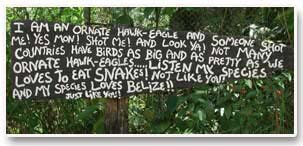 In
Belize many of the indigenous animals are hunted for food or killed because
they are considered pests. Sharon felt that it was important to give Belizeans
information about the animals and about animal conservation. Signs hang
throughout the zoo written from the animals’ perspective and in Creole
asking for relief from hunting or dispelling common myths that have caused
their populations to dwindle. The sign over the Hawk-Eagle cage reads “I
am an Ornate Hawk-Eagle and someone shot me! Yes Mon! Shot Me! And look
ya! Not many countries have birds as big and as pretty as we Ornate Hawk-Eagles…Listen…my
species loves to eat snakes! Not like you! And my species loves Belize!
Just like you!”
In
Belize many of the indigenous animals are hunted for food or killed because
they are considered pests. Sharon felt that it was important to give Belizeans
information about the animals and about animal conservation. Signs hang
throughout the zoo written from the animals’ perspective and in Creole
asking for relief from hunting or dispelling common myths that have caused
their populations to dwindle. The sign over the Hawk-Eagle cage reads “I
am an Ornate Hawk-Eagle and someone shot me! Yes Mon! Shot Me! And look
ya! Not many countries have birds as big and as pretty as we Ornate Hawk-Eagles…Listen…my
species loves to eat snakes! Not like you! And my species loves Belize!
Just like you!”
Like zoos worldwide, zoo personnel attempt to recreate the animals’
natural habitat. The animals are kept in open topped enclosures that make
it seem like you are in the wild with them. This is great for many of the
animals, but a little bit scary when getting close to the jaguars.
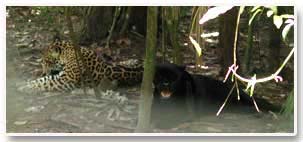 There
are two jaguar sisters in the zoo. One is the more commonly known
There
are two jaguar sisters in the zoo. One is the more commonly known 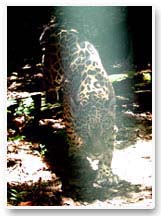 type
with obvious spots and the other is all black. We learned however, that
all jaguars have spots. You just can’t see them clearly on the black
jaguars. Black fur is a recessive trait and therefore less common. The jaguar
has the largest brain per body mass of any cat in the world. They are stealth
hunters whose name means “able to overcome its prey with one bound.”
Being this close to such a powerful animal is awe-inspiring. Belize has
a special area of land set aside as a jaguar preserve and there is a healthy
population of jaguars in Belize. The natural jaguar population is an indicator
of the general overall health of the jungle ecosystem. If jaguars are thriving,
then the animals they hunt as prey are thriving, and the entire environment
is in balance. Jaguars historically have been hunted for their beautiful
coats and because they are feared.
type
with obvious spots and the other is all black. We learned however, that
all jaguars have spots. You just can’t see them clearly on the black
jaguars. Black fur is a recessive trait and therefore less common. The jaguar
has the largest brain per body mass of any cat in the world. They are stealth
hunters whose name means “able to overcome its prey with one bound.”
Being this close to such a powerful animal is awe-inspiring. Belize has
a special area of land set aside as a jaguar preserve and there is a healthy
population of jaguars in Belize. The natural jaguar population is an indicator
of the general overall health of the jungle ecosystem. If jaguars are thriving,
then the animals they hunt as prey are thriving, and the entire environment
is in balance. Jaguars historically have been hunted for their beautiful
coats and because they are feared.
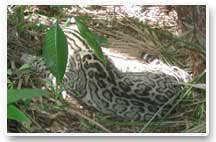 There
are four other cats in the Belize Zoo—the ocelot, puma, margay, and
jaguarundi. Most of these cats are nocturnal meaning they sleep during the
day and hunt at night. It was hard to spot some of them as they slept camouflaged
under branches and shrubs. The spotted coats of many of the cats allows
them to blend into the forest floor completely. We learned that the puma
is the same species, Felis Concolor, as what we call a cougar, a mountain
lion, or a red tiger.
There
are four other cats in the Belize Zoo—the ocelot, puma, margay, and
jaguarundi. Most of these cats are nocturnal meaning they sleep during the
day and hunt at night. It was hard to spot some of them as they slept camouflaged
under branches and shrubs. The spotted coats of many of the cats allows
them to blend into the forest floor completely. We learned that the puma
is the same species, Felis Concolor, as what we call a cougar, a mountain
lion, or a red tiger.
While we watched the ocelot, we noticed a very strong smelly oder. At first
we thought the 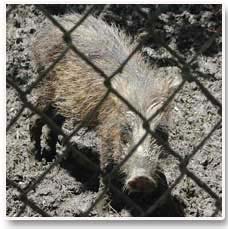 hot
bus ride had caught up with us and what we were smelling was each other.
As we turned to view the White Lipped Peccary and Collared Peccary we realized
it wasn’t us after all but the peccaries or warree as they are called
locally. The strong smell is how these animals communicate with each other.
They have scent glands on their backs that they rub against each other as
an introduction and on trees to mark their territory. The White Lipped Peccary
is endangered due to habitat destruction and hunting. They are easy targets
because they travel in groups allowing a hunter to kill many animals at
once. Today it is illegal to hunt peccary in Belize.
hot
bus ride had caught up with us and what we were smelling was each other.
As we turned to view the White Lipped Peccary and Collared Peccary we realized
it wasn’t us after all but the peccaries or warree as they are called
locally. The strong smell is how these animals communicate with each other.
They have scent glands on their backs that they rub against each other as
an introduction and on trees to mark their territory. The White Lipped Peccary
is endangered due to habitat destruction and hunting. They are easy targets
because they travel in groups allowing a hunter to kill many animals at
once. Today it is illegal to hunt peccary in Belize.
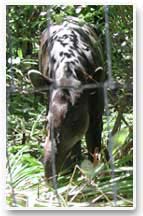 Another
star of the zoo is April the tapir. The tapir is the national animal of
Belize and the largest land mammal in Central America or the neotropics.
Manatees are larger, but they live in the water. The tapir has a long nose
like an elephant or anteater, but is actually related to the horse and rhinoceros.
Locally it is called the "Mountain Cow." To escape danger tapirs
find a stream or river to enter and then walks underwater to the other side
of the river. Tapirs are herbivores, meaning they eat plants and not other
animals. When their babies are born they have stripes that help camouflage
them from animals that prey on them like jaguars. Hunting and habitat loss
are the main reasons the tapir population is decreasing all over Central
America. Today, there are large
Another
star of the zoo is April the tapir. The tapir is the national animal of
Belize and the largest land mammal in Central America or the neotropics.
Manatees are larger, but they live in the water. The tapir has a long nose
like an elephant or anteater, but is actually related to the horse and rhinoceros.
Locally it is called the "Mountain Cow." To escape danger tapirs
find a stream or river to enter and then walks underwater to the other side
of the river. Tapirs are herbivores, meaning they eat plants and not other
animals. When their babies are born they have stripes that help camouflage
them from animals that prey on them like jaguars. Hunting and habitat loss
are the main reasons the tapir population is decreasing all over Central
America. Today, there are large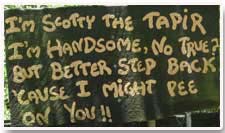 forest reserves in Belize to protect the remaining populations. Apparently,
tapirs have the ability to shoot long distances when urinating. The sign
warns visitors to stand back.
forest reserves in Belize to protect the remaining populations. Apparently,
tapirs have the ability to shoot long distances when urinating. The sign
warns visitors to stand back.
The zoo celebrates April’s birthday on the first Friday in April and
many school children come to the zoo to celebrate. Children crowd around
the cage and watch as a special cake made of vegetable mash is fed to her.
 There
are many birds in the zoo. Many of their enclosures have net spread over
the top to keep the birds safe and to keep them in their zoo home. These
enclosures are large enough for the birds to fly and have large trees inside
for perching. We saw Keel-billed Toucans, that you may recognize from a
popular cereal box. Toucans have a large colorful bill that is made out
of something similar to fingernails. The toucan’s large bill is hollow,
so it doesn’t weigh much more than feathers. Keel-billed toucans are
the national bird of Belize and are still found in the wooded areas in most
of Central America. We saw the
There
are many birds in the zoo. Many of their enclosures have net spread over
the top to keep the birds safe and to keep them in their zoo home. These
enclosures are large enough for the birds to fly and have large trees inside
for perching. We saw Keel-billed Toucans, that you may recognize from a
popular cereal box. Toucans have a large colorful bill that is made out
of something similar to fingernails. The toucan’s large bill is hollow,
so it doesn’t weigh much more than feathers. Keel-billed toucans are
the national bird of Belize and are still found in the wooded areas in most
of Central America. We saw the toucans eating watermelon, but they eat all kinds of fruit and berries as
well as an occasional snake, lizard or insect.
toucans eating watermelon, but they eat all kinds of fruit and berries as
well as an occasional snake, lizard or insect.
The Scarlet Macaw is one of the largest and most beautiful birds in Belize.
The bright colors and long life span (up to 100 years) make them targets
for poachers who sell the birds as pets. You may have even seen one in a
pet store where you live. It is now illegal to sell or keep Scarlet Macaws
as pets, but it may be too late. There are less than 200 of them remaining
in Belize and they need a large forest for their population to be successful.
In addition to the population being reduced through poaching, habitat loss
has made it difficult for them to survive in the wild. They are one of the
most endangered bird species in Belize. We saw flocks of Blue and Gold Macaws
when we were on the Amazon, but we only saw one Scarlet Macaw.
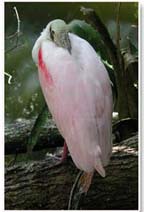 Jabiru
are huge birds that mate for life and return yearly to the same nests. A
large black bill and red collar with a huge white body make them easy to
identify if you are ever lucky enough to see one in the wild. However, they
are the most endangered bird in Belize and live in the wetlands. We could
not get a good picture of the Jabiru, but did get one of the Roseatee Spoonbill.
Jabiru
are huge birds that mate for life and return yearly to the same nests. A
large black bill and red collar with a huge white body make them easy to
identify if you are ever lucky enough to see one in the wild. However, they
are the most endangered bird in Belize and live in the wetlands. We could
not get a good picture of the Jabiru, but did get one of the Roseatee Spoonbill.
We also saw Brown Pelicans, Red Lored Parrots, Yellow-headed Parrots, Barn
Owls, Black Hawks, Mottled Owls, Great Egrets, Roseatee Spoonbills, Black-belly
Whistling Ducks, King Vultures, and the Ornate Hawk-Eagle.
There are two types of monkeys living in the zoo—the spider monkey
and the howler monkey. The spider monkeys we saw were swinging through the branches, making us think they were showing off for us. Spider monkeys
are endangered and their population was dramatically reduced due to an epidemic
of yellow fever. The sign next to the spider monkeys pleaded with people
to not keep spider monkeys as pets. Taking them for pets as well as hunting
and habitat destruction are the main threats to spider monkeys today. We
can see why a person would want one for a pet as they are so cute. Yet they
actually make very bad pets because they need lots of space and the company
of other monkeys to be happy.
the branches, making us think they were showing off for us. Spider monkeys
are endangered and their population was dramatically reduced due to an epidemic
of yellow fever. The sign next to the spider monkeys pleaded with people
to not keep spider monkeys as pets. Taking them for pets as well as hunting
and habitat destruction are the main threats to spider monkeys today. We
can see why a person would want one for a pet as they are so cute. Yet they
actually make very bad pets because they need lots of space and the company
of other monkeys to be happy.
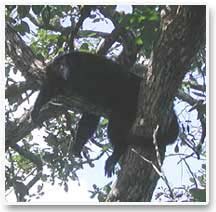 We
almost missed the howler monkeys because they were sleeping in the treetops.
The locals call them baboons although they are not true baboons as are found
in Africa. They looked so funny hanging with their tails hooked around a
branch and their arms and legs dangling down. We wanted to hear their howling,
but like in the Amazon, they normally howl only at dawn and dusk. We have
missed waking up to the howlers on our last two expeditions. Howlers have
a special reserve in Belize to try and protect the remaining population.
We
almost missed the howler monkeys because they were sleeping in the treetops.
The locals call them baboons although they are not true baboons as are found
in Africa. They looked so funny hanging with their tails hooked around a
branch and their arms and legs dangling down. We wanted to hear their howling,
but like in the Amazon, they normally howl only at dawn and dusk. We have
missed waking up to the howlers on our last two expeditions. Howlers have
a special reserve in Belize to try and protect the remaining population.
One of the main objectives of the zoo is to teach the children and people
of Belize about conservation and their native animal populations. Each year
hundreds of school children visit the Belize Zoo to observe the animals
and interact with the display activities. Inside the Visitors' Center there
are many displays designed to teach students about the animals. The zoo
holds an environmental fair where schools compete for computers and other
prizes and provides local teachers with training on how to teach conservation
topics to their students. Hopefully, visiting students will develop respect
and appreciation for their native animals and their need for habitat protection.
There is a manatee skeleton hanging from the roof of the Visitor's Center.
It is almost a complete skeleton. Looking at the 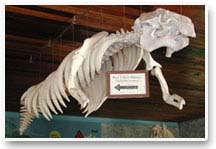 skeleton,
you could never imagine how odd-looking manatees actually are. Michael noticed,
because of Caryn’s lecture the other day, that the finger bones were
not on this skeleton.
skeleton,
you could never imagine how odd-looking manatees actually are. Michael noticed,
because of Caryn’s lecture the other day, that the finger bones were
not on this skeleton.
Like animals worldwide, those native to Belize also suffer from habitat
destruction. Of the 40 types of animals now living in the zoo, many are
endangered. What do you think is the best way to protect these animals?